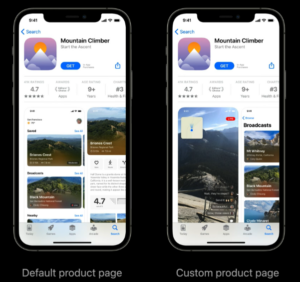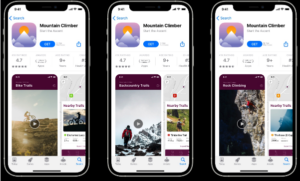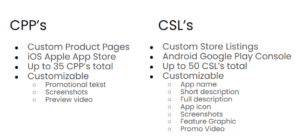With the release of the iOS15 app features, the Apple App Store has revolutionized the targeting options in the app stores. After the limitations of iOS14 SKAdNetwork, app owners were challenged in their advertising strategies, with less information and personalization opportunities. With the ability to create customized product pages in the app stores, 2022 is providing new improvements to connect with the audience.
While both stores have different names for them, Custom Product Pages (Apple) and Custom Store Listings (Google) have overlapping features. Both show different representations of the product page (the landing page for an app in the app store), which can only be reached through the use of a unique URL. This is distinct from the organic product page, which will always show the same product page, regardless of the user’s journey. Through this unique URL, you can target users from a specific advertising channel, or ad group, in order to communicate specific information through the customized product pages.

By creating different product pages or store listings, you can customize what the new user sees in the app store, and communicate the same message from the banner/link they clicked on. In the above example, you can see the default product page where all new users that organically arrive at the app in the app store, and the custom product page, which only targeted users arrive at via a specific URL. In the example shown below you can see different variations of the custom product pages for the Mountain Climber app, targeting different users: one for bike trails, one for backcountry trails, and one specific for rock climbers.

By customizing the product pages to match your targeted audience, you can increase the conversion rate from the click on your advertisement, to the download. This not only decreases the costs of your cost per install, but also increases the conversion rate from impression to download in the app stores, increasing your app’s strength in the stores. However, it is important to make sure that the specific CPP or CSL does in fact connect the right group to the right product page, otherwise your efforts are ineffective.
The Apple App Store came with their CPP feature in Q1 of 2022, after a few set-backs in the release date. Advertising platforms, such as Apple Search Ads required some more time in order to be able to implement the feature, which makes the use of CPP’s quite new. Google responded quietly at the end of May in 2022 by expanding their existing Custom Store Listings to compare to the CPPs. App’s setting up Custom Product Pages or Custom Store Listings are thus ahead of the competition, and increasing their conversion rates.
Since Google was a bit later in bringing this feature out, they were able to enhance this feature, leading to a few differences between the two:

Similarly however, both CPPs and CSLs have to be approved in an app review before they can go live, and both are only accessible through a unique link. Organic traffic will thus not be influenced by the introduction of these customized product pages.
Other than targeting specific groups (ages, interests, USP’s), you can gain valuable information about what your target audience finds important. By using the results and dashboards for insights in the conversion ratios from CPP’s and CSL’s, you can “test” the efficiency of different CPP’s/CSL’s. You can test different colors, or different screenshot combinations. For example, are mountain bikers from traffic source X more interested in trails nearby (map view) or in attractive mountain bike trails (videos)? By trying different CPP’s/CSL’s, you can gather more information to target your audience.
While you have the opportunity to have 35 CPP’s live in the Apple App Store, and 50 CSL’s in the Google Play Store, we recommend starting with no more than 10 or 15, in order to get the hang of the process. Create a map of the different target groups that you are trying to reach on different advertising platforms, and create screenshots/videos that are most likely to fit their needs. Keep in mind that these still have to be compliant with the apple app and google play store requirements. Once live, connect them to your advertising platforms in campaigns or ad groups that are specific to that certain customized product page.
Want to know more about Custom Product Pages, Custom Store Listings, or stay up to date with all new features available in the app stores? Get in touch with us!
© 2025 Wuzzon. All rights reserved
"*" indicates required fields